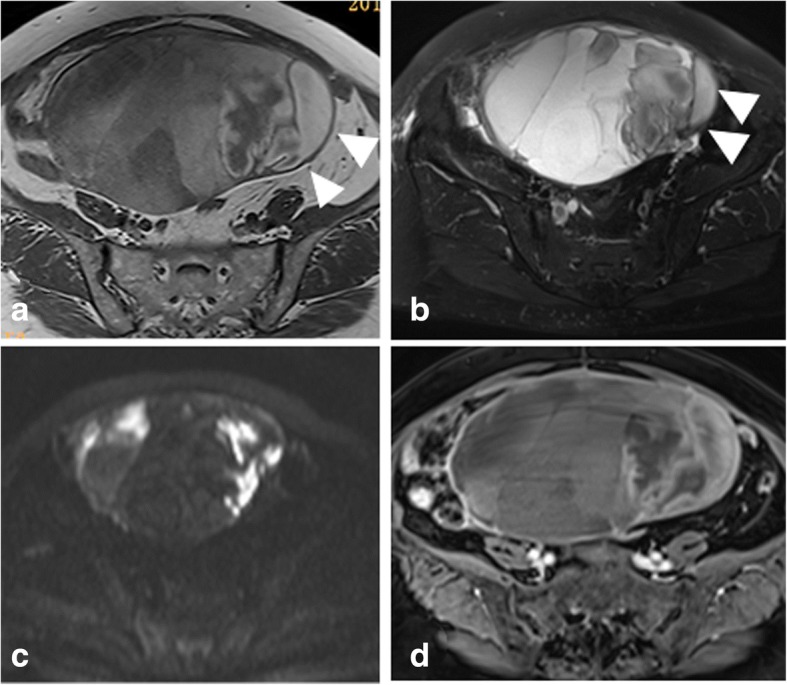Sexcord/ stromal ovarian tumors MRI: Difference between revisions
(→MRI) |
(→MRI) |
||
| Line 17: | Line 17: | ||
==MRI== | ==MRI== | ||
*MRI may be helpful in the diagnosis of Sexcord/ stromal ovarian tumors | *MRI may be helpful in the diagnosis of Sexcord/ stromal ovarian tumors<ref name="pmid15972425">{{cite journal |vauthors=Jung SE, Rha SE, Lee JM, Park SY, Oh SN, Cho KS, Lee EJ, Byun JY, Hahn ST |title=CT and MRI findings of sex cord-stromal tumor of the ovary |journal=AJR Am J Roentgenol |volume=185 |issue=1 |pages=207–15 |date=July 2005 |pmid=15972425 |doi=10.2214/ajr.185.1.01850207 |url=}}</ref> | ||
*Findings on MRI differ according to the subtypes of tumors | *Findings on MRI differ according to the subtypes of tumors | ||
'''Granulosa cell tumors''': | '''Granulosa cell tumors''': | ||
| Line 23: | Line 23: | ||
*They appear as solid masses, tumors with hemorrhagic or fibrotic changes, multilocular cystic lesions or completely cystic tumors | *They appear as solid masses, tumors with hemorrhagic or fibrotic changes, multilocular cystic lesions or completely cystic tumors | ||
*Heterogeneity within a solid tumor is caused by intratumoral bleeding, infarct or fibrous degeneration | *Heterogeneity within a solid tumor is caused by intratumoral bleeding, infarct or fibrous degeneration | ||
[[File:Granulosa cell tumor MRI findings.jpg|400px|thumb|none|A 54 -year-old woman with primary adult type OGCT (Ic). The mass shows as the purely cystic lesion with mostly high signal on T1WI (a) and T2WI (b). Note, the hemorrhagic contents locates on the left side of the tumor, representing the relatively high signal on T1WI and low signal on T2WI (arrowhead) and high signal on DWI (c). After injection of contrast medium, the cystic wall shows minor enhancement (d),Zhang H, Zhang H, Gu S, Zhang Y, Liu X, Zhang G. MR findings of primary ovarian granulosa cell tumor with focus on the differentiation with other ovarian sex cord-stromal tumors. J Ovarian Res. 2018;11(1):46. Published 2018 Jun 5. doi:10.1186/s13048-018-0416-x,https://www.ncbi.nlm.nih.gov/pmc/articles/PMC5989475/]] | [[File:Granulosa cell tumor MRI findings.jpg|400px|thumb|none|A 54 -year-old woman with primary adult type OGCT (Ic). The mass shows as the purely cystic lesion with mostly high signal on T1WI (a) and T2WI (b). Note, the hemorrhagic contents locates on the left side of the tumor, representing the relatively high signal on T1WI and low signal on T2WI (arrowhead) and high signal on DWI (c). After injection of contrast medium, the cystic wall shows minor enhancement (d),Zhang H, Zhang H, Gu S, Zhang Y, Liu X, Zhang G. MR findings of primary ovarian granulosa cell tumor with focus on the differentiation with other ovarian sex cord-stromal tumors. J Ovarian Res. 2018;11(1):46. Published 2018 Jun 5. doi:10.1186/s13048-018-0416-x,https://www.ncbi.nlm.nih.gov/pmc/articles/PMC5989475/]] | ||
Revision as of 18:02, 17 April 2019
|
Sexcord/ stromal ovarian tumors Microchapters |
|
Differentiating Sexcord/ Stromal Ovarian Tumors from other Diseases |
|---|
|
Diagnosis |
|
Treatment |
|
Case Studies |
|
Sexcord/ stromal ovarian tumors MRI On the Web |
|
American Roentgen Ray Society Images of Sexcord/ stromal ovarian tumors MRI |
|
Risk calculators and risk factors for Sexcord/ stromal ovarian tumors MRI |
Editor-In-Chief: C. Michael Gibson, M.S., M.D. [1]; Associate Editor(s)-in-Chief:
Overview
There are no MRI findings associated with [disease name].
OR
[Location] MRI may be helpful in the diagnosis of [disease name]. Findings on MRI suggestive of/diagnostic of [disease name] include [finding 1], [finding 2], and [finding 3].
OR
There are no MRI findings associated with [disease name]. However, a MRI may be helpful in the diagnosis of complications of [disease name], which include [complication 1], [complication 2], and [complication 3].
MRI
- MRI may be helpful in the diagnosis of Sexcord/ stromal ovarian tumors[1]
- Findings on MRI differ according to the subtypes of tumors
Granulosa cell tumors:
- They show heterogeneous signal intensity on both T1WI and T2WI and high signal intensity on DWI images
- They appear as solid masses, tumors with hemorrhagic or fibrotic changes, multilocular cystic lesions or completely cystic tumors
- Heterogeneity within a solid tumor is caused by intratumoral bleeding, infarct or fibrous degeneration

References
- ↑ Jung SE, Rha SE, Lee JM, Park SY, Oh SN, Cho KS, Lee EJ, Byun JY, Hahn ST (July 2005). "CT and MRI findings of sex cord-stromal tumor of the ovary". AJR Am J Roentgenol. 185 (1): 207–15. doi:10.2214/ajr.185.1.01850207. PMID 15972425.